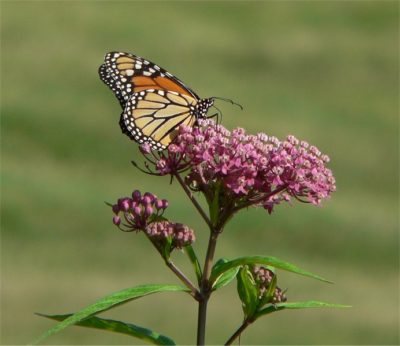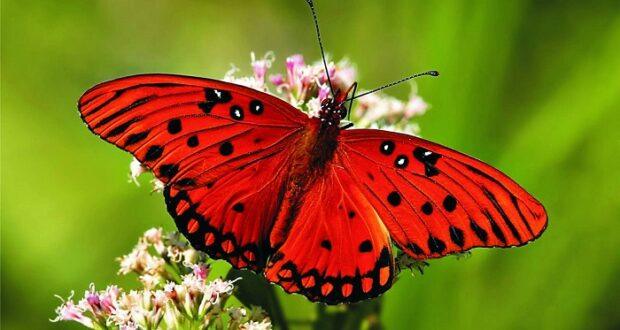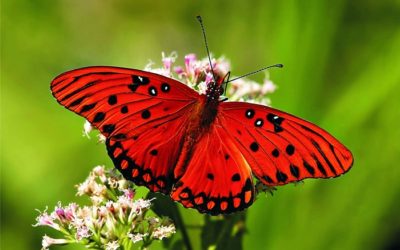Butterflies — those small, beautiful “flying flowers” of nature — are always a welcome sight in our gardens and herald the coming of summer. Their unique and colorful designs inspire artists and enchant children. How do we encourage butterflies to visit our garden?
By having a variety of annuals, perennials, trees and shrubs that bloom, nectar will be available all season long. Plant flowers and herbs that will feed all stages of butterflies. Caterpillars, newly emerged butterflies and mature butterflies all have their favorite type of food. Butterflies enjoy flowers both big and small, and the garden can be a large plot or just a window box. They also like open, sunny places that have water and shelter from the wind.
Find out which butterflies are common in your area and then plant flowers they like. Even try planting flowers for rarer butterflies because you never know what you may get. Combine herbs and flowers with shrubs and trees to create shelter. Of course, avoid insecticides and pesticides.
The Best Source For Non-GMO Heirloom Seeds Is Right Here!
Let’s take a look at some common flowers that attract butterflies. Keep in mind: These are the most common ones, and there is an endless list of flowers and herbs for butterflies.
1. Horsemint
Horsemint is considered an herb. It does its best in late summer and early fall, around September and October. It has square stems and lance-shaped leaves. Horsemint grows in clumps and varies in size from six inches to three feet. It often has purple or pink flowers. Horsemint does best in moist soil and full sun.
2. Dill
Here is another herb. It provides food for caterpillars as well as camouflage for all stages. Dill even provides food for the newly emerged butterflies. Dill blooms in late spring and early summer. It is known for getting quite tall, so plant it near the back of your garden to ensure it doesn’t overshadow smaller flowers. Dill has tiny, bright yellow flowers. It grows well in most soils and amounts of sunlight.
3. Fennel
Large, “lacy,” yellow flowers grace this herb. Fennel has been described as a feathery-style herb. It likes a lot of sun and well-draining, yet moist soil. It can grow up to three or five feet. Fennel blooms best in the months of July and August. It also can be used for other household things so is a very helpful plant for all.
4. Milkweed

Milkweed is a popular attractant for Monarch butterflies.
Although it has “weed” in the name, milkweed has beautiful flowers and is incredibly necessary for the survival of the Monarch butterfly. It loves sun and can grow from two to six feet. There are many varieties, and butterflies enjoy them all. Milkweed has thick stalks and large, green, waxy leaves. The stems become hollow as the plant matures. Milkweed flowers can be pink, purple or orange and bloom between the months of June and August.
5. Aster
A flower with many varieties, the Aster blooms closer to the fall months, but some asters can bloom anytime from spring to the first frost. It is usually a tall plant, ranging from 24 inches to five feet high. It is a multi-petaled flower with a button-like center. Asters range in colors of white, blue, purple, red and pink, with centers of yellow. Asters do best in full sun with well-drained soil.
6. Phlox
Phlox is a popular and pretty flower. It has tall stems, sometimes reaching up to four feet in height. It blooms from summer to fall, loving the full sun and well-drained soil. Phlox comes in all types of colors, the most common being pink, red, shades of purple, salmon and even white blooms.
7. Pansy
Arguably one of the most popular, annual garden flowers, pansies come in limitless varieties of colors. Some even have two or three colors. Pansies have heart-shaped, overlapping petals with face-like markings in the center. This flower handles cold well, but likes having full sun or partial shade. It is a stocky or bushy style of flower and only gets to be about four to eight inches tall.
The Secrets Of Sea Minerals To Grow More “Nutritionally-Dense Food” Than You Can Possibly Eat!
8. Coneflower
This is a low-maintenance prairie flower. It has large flowers in a variety of colors, with drooping petals and dark centers. It is hardy and long-blooming. Coneflowers can grow between two and four feet in height, doing most of their blooming in mid-summer. This type of flower loves full sun, but can handle partial shade. Be aware: Coneflowers will reach for the sun.
9. Snapdragon
Children and adults alike love snapdragons, making this flower popular all over the country. Very easy to grow and maintain, snapdragons come in limitless varieties of bright colors. Full sun to partial shade helps this flower do its best, and well-drained soil is needed, too. Snapdragons are a bushy-type perennial plant, and seem to do well in cooler weather.
10. Stargazer Lily
This is a tall, slender and elegant flower. It can grow up to three feet in height and has light pink to deep crimson blooms with dark spots and dark green leaves. The lily is a bulb plant. It flowers in the summer, usually between June and July. Stargazer lilies do best in full sun with well-drained soil.
Having a butterfly garden will bring a limitless amount of color and activity to your life. Enjoy watching the caterpillars grow into butterflies and then fly around your flowers and yard. It’s nature, pure and simple.
Have you grown a butterfly garden? Which flowers worked best for you? Share your tips in the section below:

